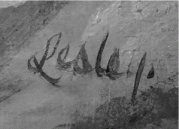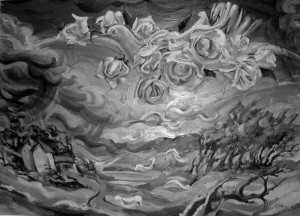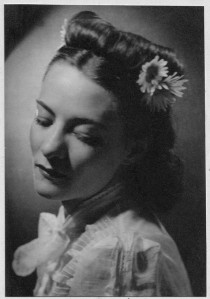My mother was a painter. She painted in oils, gouache and watercolours, and drew and sketched with pencil or in inks. Throughout her life she produced a great number of oil paintings and other artworks, some of extremely high quality. She trained at the Camberwell in London, starting there, as I reconstruct it, at the age of twenty-five, just after the Second World War. The Camberwell at that time still offered a curriculum that regarded oil-painting as a craft, and along with drawing and composition, she was taught to prime canvases or board with French chalk and pearl glue, and to grind and mix and apply pigments in much the same way as painters had done for the last five hundred years. She favoured an earthy palette with colours like burnt sienna and burnt umber, the names of which seemed like spells to me, enabling me to see those Italian realms in flames, as though the scenes from her Renaissance art books had caught fire.
At some stage during the years when she was still with my father, she shared a studio with Gregoire Boonzaaier. From that era I recall only a single image, in multi-sensual detail: the ochre-brown plasticine in the studio that was used for making sculptural maquettes. We were allowed to play with it.
 Her departure from Cape Town ended a promising career as a painter, for she left the company, support and mythology of her bohemian and leftist peers in the Cape. She was not much known by Transvaal galleries or art buyers, and struggled to build a niche for herself as a serious painter. The sale of a painting was an important event, but I was excluded from the transaction of such sales, being sent to play. She signed them with her first name only: Lesley.
Her departure from Cape Town ended a promising career as a painter, for she left the company, support and mythology of her bohemian and leftist peers in the Cape. She was not much known by Transvaal galleries or art buyers, and struggled to build a niche for herself as a serious painter. The sale of a painting was an important event, but I was excluded from the transaction of such sales, being sent to play. She signed them with her first name only: Lesley.
The signature on a painting has a special meaning over and above whatever signification the picture carries. Although it can be counterfeited, its function is ostensibly to ensure that the goods are not counterfeit, that a specific artist had ‘authored’ or ‘owned’ the work.
 Like Thomas Knox’s seal, it is a guarantee of personhood. It confers an air of authenticity on the wordless, drawing it into the realm of the written text. It suggests also that the artist’s hand has hovered in exactly this spot, marking the artwork, and allows us, perhaps by placing our own hand there, to come into a bodily congruence. The artist, like God, has looked upon the creation and found it good. The day that I write about my mother having studied at the Camberwell I am visited by Beatrice, who inhabits a blurry region between friend and client. The appointment to design a ring becomes an afternoon of familial bonhomie, with her three children and our twins playing in the garden and swimming pool. She tells me about her eighty-year-old father, and how since her mother died he has become interested in cooking. She describes the domestic details of the ordered day he leads, which includes painting, mostly in watercolours. I tell her about my father, who spent the last years of his life within miles of where hers now lives in England.
Like Thomas Knox’s seal, it is a guarantee of personhood. It confers an air of authenticity on the wordless, drawing it into the realm of the written text. It suggests also that the artist’s hand has hovered in exactly this spot, marking the artwork, and allows us, perhaps by placing our own hand there, to come into a bodily congruence. The artist, like God, has looked upon the creation and found it good. The day that I write about my mother having studied at the Camberwell I am visited by Beatrice, who inhabits a blurry region between friend and client. The appointment to design a ring becomes an afternoon of familial bonhomie, with her three children and our twins playing in the garden and swimming pool. She tells me about her eighty-year-old father, and how since her mother died he has become interested in cooking. She describes the domestic details of the ordered day he leads, which includes painting, mostly in watercolours. I tell her about my father, who spent the last years of his life within miles of where hers now lives in England.

Both old men, living singly, had managed a creative and lucid life among neighbours.
I am interested in her father’s painting. Did he take it up in his old age? No, Beatrice tells me, he was a trained artist. He studied at the Camberwell in the years right after the war. I give her pictures of the young Lesley, prints of her work and pages of my writing. She says she will write to her father and ask him if he recalls her from that time. The photograph that I find was taken by Anne Fischer, a society photographer who was active in Cape Town in the 1940s. It makes Lesley look like a film star, like Garbo or Dietrich. She has high cheekbones and her hair is done up in a complex knot with daisies. As I go downstairs with Bea’s husband, David, I say to him, ‘She was a beautiful woman. If they were there at the same time, I feel sure he would have noticed her.’ David smiles and agrees. Bea’s father was very interested in women, he tells me.
____________
Part 1 Part 2 Part 3 Part 4 Part 5 Part 6 Part 7 Part 8 Part 9 Part 10
